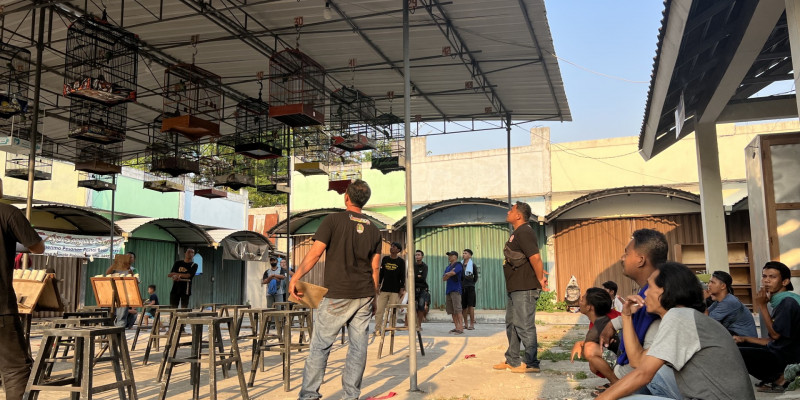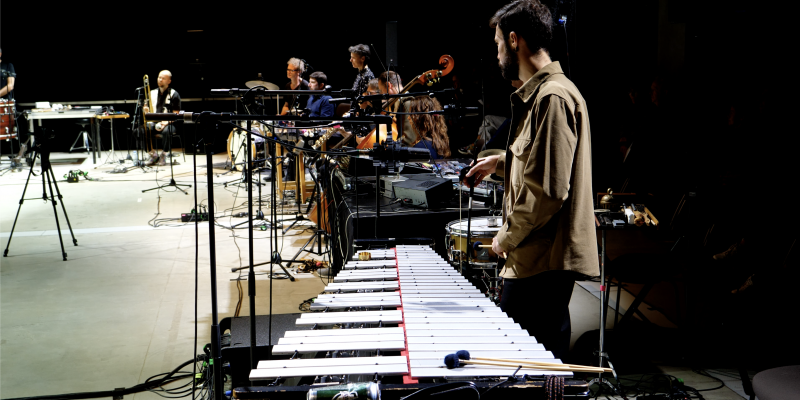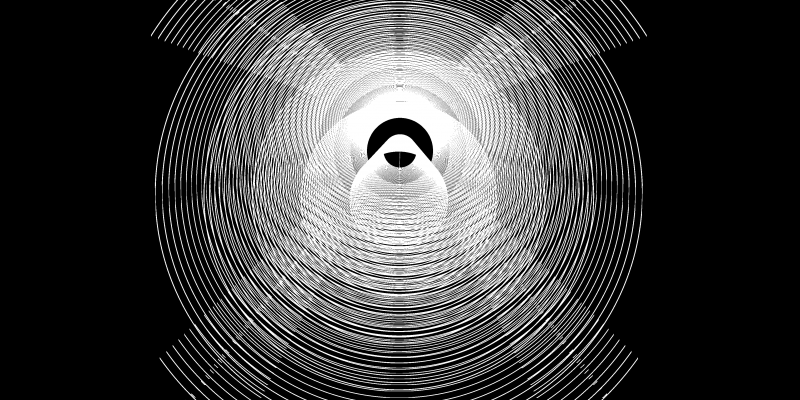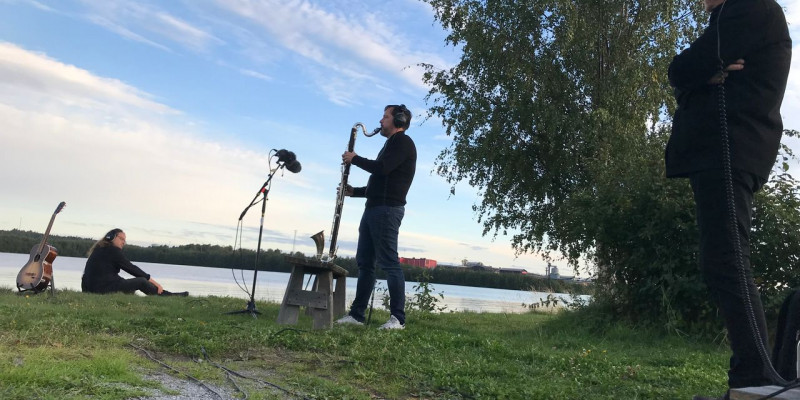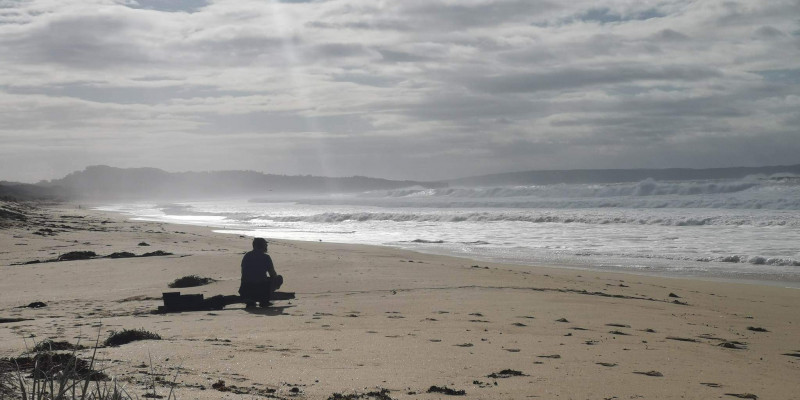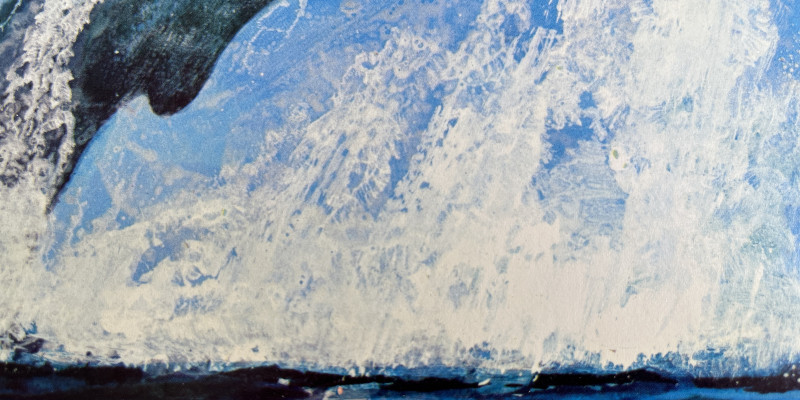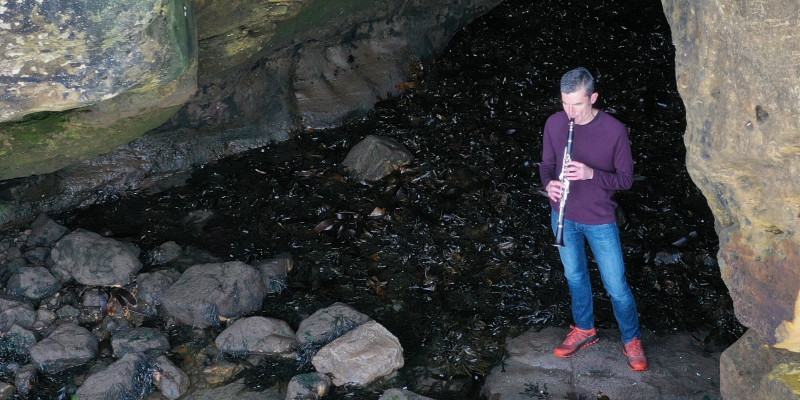Sonic animism?
Abstract
Drawing from examples of recent sound works and research the audiopaper explores the idea of listening to biophonic and geophonic »voices« as a form of technologically aided sonic animism. Field recording is understood as a practice of listening seeking heightened awareness and environmental connectedness and sonic research as 'deep' listening into scientific audio collections and archival sound. The audio paper features examples from the author’s recent compositions, radiophonic works and installations, and reflects on perceived sonic animism through the sound material. The compositions are contextualised as works relating to climate change and ecological crises and encompassing broader narratives: Rediviva intermixta, a sound installation/radiophonic work for Oscillations, a collaboration between University of the Western Cape and Akademie der Künste Berlin, includes sounds of wind, water and ocean, plants and animals, wooden constructions and metal fences at places with historical and current political and societal significance; Homeostasis, an audiovisual installation presented in two natural history museums asks questions about anthropocentric perspectives on bioacoustic voices. By acknowledging that the voices of animals communicating underwater, and therefore in a medium of sound strange to human ears, will always be alien to humans, the work – composed with scientific research recordings – aims to appreciate otherness in these voices. Future Forest, a currently ongoing project, in collaboration with ecoacoustic researchers from Freiburg University, relates to the ecosystem forest: the Black Forest and old-growth forest in Brandenburg. The paper describes how, in making the first recordings of wind, sounding through different tree species with contact mikes connected to the trunk of a tree, transported us into a state of »animistic listening«, even a spiritual form of insight and realisation (»everything is connected«).
Listening on your mobile device? Here's a direct link to Soundcloud
Autumn 2024, on a trail around the Feldberg in the Black Forest in Southern Germany. Together with a biologist from the Geobotany department at the University of Freiburg we are visiting sites of ecoacoustic research. We enter an old-growth forest with mixed tree species that has only really been harvested once in the 18th century and since then has hardly been cultivated by humans, more or less left to rewild.
I attach a contact microphone to the trunk of a tree, at the bottom end very close to the forest floor. What we can hear through the headphones is the wind animating the tree – every gentle gust of wind that moves the individual branches ever so slightly is transmitted through the trunk and the microphone. Even two tiny birds (goldcrests) hopping around, touching the branches with their feet become audible.
At another tree we hear a sound that seems mysterious at first, a squeaking utterance like a call by an animal. For a while we – the ecoscientist and I – can't discern if it is in fact an animal, or a sound of the tree, in the end we decide it must be two branches rubbing against each other.
The contact microphone opens up the possibility of listening »from within« – and what is conveyed is an aural glimpse into a large networked system. Biophonic and geophonic voices become undistinguishable. Sitting by the tree, observing and listening with all our senses is a mode of perception and contemplation we »sink into« – hineinversunken sein is a fitting German expression for this state of heightened awareness in the here and now. There is the sensation of awe – an »awe of nature« – leading to the realization, acknowledgement, a different form of knowing that »everything is connected«, influences each other, belongs together. Tuning into the sound of the tree and wind transported us to a state of animistic listening, even a spiritual form of insight and realisation.
Animism is the belief that all things, creatures, plants, the natural world and human handiwork are alive and possess agency. The word animism comes from anima, spirit, breath - here, the wind's breath blowing into the trees and plants is the instigator for the interaction between organic and meteorological systems.
In The Spell of the Sensuous, David Abram describes how a shaman or sorcerer in indigenous communities acts as an intermediary between the human community and the larger ecological field through animistic, spiritual practice and rituals.
Can we draw a parallel – can deep listening aided by technology, by sensors and microphones, amplifiers, recorders and headphones, be regarded as a spiritual practice linking the human and the more-than-human world today?
This question I will explore further through examples of three recent sound works related to different locations and contexts. Sonic animism is associated with the blending of biophonic and geophonic sound, and to the sounding of places that reveal ecological, societal and historic interdependencies.
In August 2023 I travelled to South Africa for a collaborative project between artists and researchers from Cape Town and Berlin. Continuing my ecoacoustic research of earlier works I visited various sites in and around Cape Town and the Northern Cape and investigated questions around listening, soundscapes, ecology, land rights, place and political history.
The vegetation of the so-called Cape Floral Region is one of 30 recognized biodiversity hotspots on Earth. One such extremely biologically diverse place is the small ecological reserve on former farmland Avontuur in Nieuwoudtville, about 400 km North of Cape Town.
Here I came across another puzzling, »strange« sound, where I could not discern whether it was of animal, plant or geophonic origin. It turned out to be the noise of wing flapping of the Cape Clapper Lark which is always followed by a single upward glissando whistle.
The temperature was 0 degrees in the cabin where I slept during the night with the first rays of sun in the morning there is warmth water drips from the roof and the iron of the roof expands with deep thumps
And later, once the air reaches a certain temperature, the wild flowers of the Fynbos vegetation, only during a few weeks in spring, open their petals – and the bees appear.
There are numerous bee species at Avontuur, especially solitary bee species endemic to this vegetation – highly specific in that certain species pollinate specific flowers.
Season, temperature, wild flowers, bees, all are interdependent, and this becomes audible through the sound of the landscape. Daily and seasonal cycles, linked to meteorological conditions and air temperature, are present in the sounds of the material and biological world. Connectedness becomes audible.

Also, energy becomes audible
the sound of the solar panels on the cabin roof powering a laptop
an old fashioned wind pump
the ringing, singing wires of the electricity lines passing through the landscape
amplified through the contact mike
Mechanical movement, machine humming and electromagnetic transmission:
sonic animism is extended into world of physics, the material world, the human-made world.
Moreover, listening to specific places reveals relations between other goings-on in the world relating to politics, society, history.
The Darling wind farm, 70 km from Cape Town, on a very windy day – a forlorn atmosphere.
Wind is abundant here, and although South Africa is going through an energy crisis with daily power cuts of many hours, only three wind turbines have been constructed over a period of 20 years.
wind conducted through a weathered billboard advocating a holiday near the wind farm recorded with a contact microphone
The harbour of St Helena Bay is quiet for it is not the season for fish trawlers or other boats.
But the wind is blowing,
causing a fence to rattle and a flag to flop against its pole.
These are relatively soft, insignificant sounds, but something of the atmosphere of this place captivates my imagination.
Later I find out that Saint Helena Bay is the location where Vasco da Gama first set foot in Southern Africa, apparently on 7 November, 1497.
A vent in the pier, sucking in air, and pressing it out – like breathing.
In Langebaan, a ponton, wailing.
It lies opposite of the peninsula in the Langebaan lagoon where the Donkergat whaling station was in operation between 1909-1967. When it finally closed, the region’s whaling companies had killed about 100 000 whales.
Again, I had sensed something special about this place through its sounds, before finding out what had actually happened here. History unravels later.
In Cape Town, at the Robben Island ferry pier in the V&A Waterfront compound
Another ponton squeaking, plaintively singing, lamenting.
a Cape fur seal chips in
Sedick Isaacs in his book about his experiences as a political prisoner on Robben Island writes of the »icy North Westerly wind as it swept across the Atlantic«. It left the prisoners working in the quarry exposed to the unbearably chilling cold.
I ask myself: can the history of a place, the history of what has happened here in the past, seep into one's sense of a place in the present, its atmosphere and can this happen especially through its sounds?
Maybe one answer lies in actual linkages:
At all these locations and in these recordings, wind was the driving force for the sounds. Wind might also be considered the driving force in a historical and political context: The geographical position of the Cape and the meteorological and wind conditions – powering the sailing ships – lead to exploration and trade and consequently to colonialism, subjugation of the indigenous population and slavery by abduction of people from other areas of the world brought here also on sailing ships.

The Edith Stephans Wetland Park is a nature reserve located in the Cape flats. It is surrounded by townships, as marked in the recording by the traffic sound in the background, but there is a remarkable biodiversity even in this urban setting.
A hydrophone records the pulsing clicks of aquatic insects.
Regarding his piece Chaos or the Emergent Mind of the Pond the American composer David Dunn reflects on what he hears in the sound of the water insects. He can't »accept the assumption that the creatures themselves are meaningless specks of protoplasm, forever doomed to repeat a few automatic mating calls or territorial assertions.« Instead, as a musician, he hears urgency in these calls or signals, and even a mysterious »autonomous knowing« as patterns emerge in a complex system.
Homeostasis is an audiovisual installation based on oceanographic research images and bioacoustic recordings. The sound composition is formed with voices of animals living in and around the oceans – especially whales and seals – and sounds of the sea and the oceans themselves.
Sounds and voices that can be admired as strikingly beautiful, or strange, or both ... but they will always appear somewhat alien to humans, because they are set in a medium (water) that is so different to the medium (air) where the human species listens. These sounds can mostly only be heard by humans via technology – hydrophones that record the acoustic world underwater. Questions about anthropocentric perspectives on bioacoustic voices arise. By acknowledging the human perspective as fundamentally different, one may overcome the temptation of identification, and challenge anthropocentricity by appreciating difference and otherness with empathy.
Homeostasis was presented in two natural history museums, one of them the Zoological Museum Kiel. The museum shows skeletons of whales that came to the North and Baltic Seas as occasional or stray guests over the last 160 years. In the center hall, the largest specimen is a 14 meter long skeleton of a sperm whale.
Here I had an extraordinary experience during one showing of Homeostasis when I suddenly imagined looking into the eye of this whale - although there was only the skull of a skeleton. The patterns, colours and movements of the video projected onto the animals on display and into the space, the timbres and rhythms of the biophonic and geo(aqua)-phonic sounds together with subtle electronic mimicry and transformations, made the whale come alive in my mind – other listeners experienced the same. Light and sound condensed in an imagined gaze to a moment of encounter and recognition between animal and human that seemed to transcend space and time.
In Why Look at Animals? John Berger describes how looking at each other establishes the bond between animals and humans, but he also comes to the conclusion that their connection is broken through capitalism and the industrial exploitation of the animal.
If listening – here: listening differently to scientific recordings in an artistically transformed environment - can re-establish broken connections, it can also make clear the fragility of connections or the violence with which they can be broken.
Hildegard Westerkamp speaks of the disruptive nature of listening, when listening is considered a situated practice of doing. Quote: »Out of that 'doing' comes an entirely new experiential knowledge. This is precisely what makes out the disruptive nature of listening.«
On Vanishing was a site-specific installation with 16 networked mobile speakers distributed over a meadow in a suburban area on the outskirts of Berlin. Insect vocalisations from various sound archives were used, including some from the animal sound archive of the Berlin Natural History Museum recorded 30 or 40 years ago in the same area. Small triangular flags were distributed over the meadow, informing about the massive decline of insect species over the last decades. The loudspeakers were more or less hidden in the grass, and the archival voices blended with the calls of real insects present. Furthermore, electronically processed insect sounds emphasized questioning the relationship between the real or »living« creatures and speculative beings and transformations. Where do the creatures in the grass disappear to? Upwards, downwards, to the sky, to the earth? Will new species emerge? The work opened up another astonishing experience and realization through listening: as the flags signposted a small area within the larger field of grassland, the sound emanating from within made it feel as if this were an archeological site, and we were hearing and reading about insects that are long gone.
So, whereas Homeostasis connected to the past, On Vanishing through a speculative hearing of disappearance and transformation seemed to evoke the future, even a posthuman future. Like with the examples from rediviva intermixta, listening and hearing were connected to places, bodies and objects and their animation through sound, opening up experiences of »sonic animism« – an animism transmitted through sound, mediated by technology.
